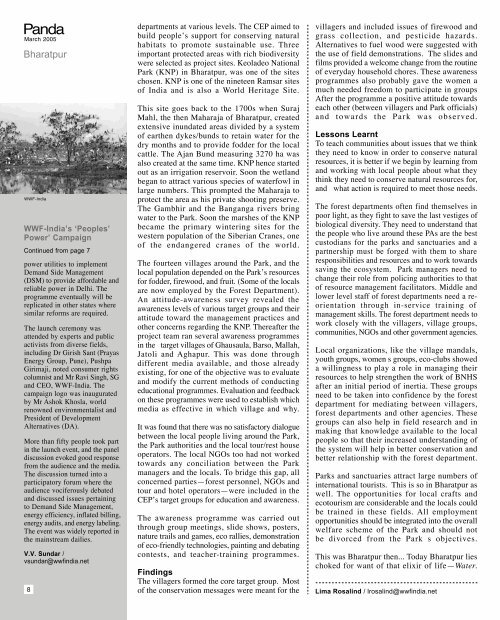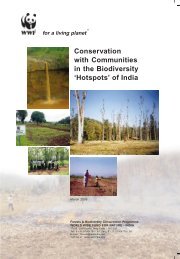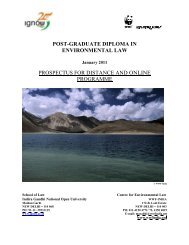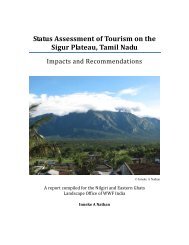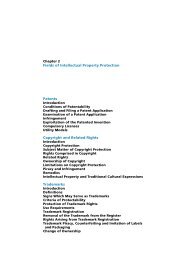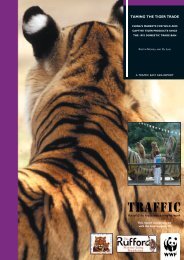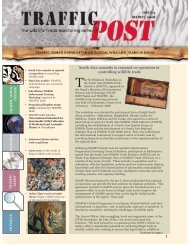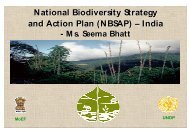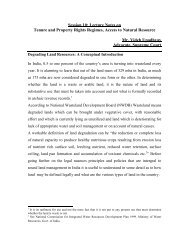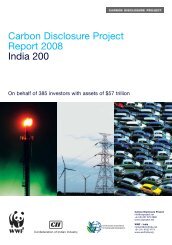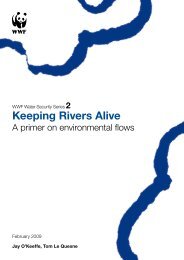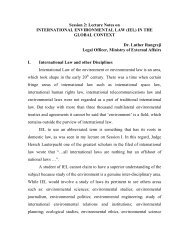The Vanishing Act - WWF-India
The Vanishing Act - WWF-India
The Vanishing Act - WWF-India
You also want an ePaper? Increase the reach of your titles
YUMPU automatically turns print PDFs into web optimized ePapers that Google loves.
Panda<br />
March 2005<br />
Bharatpur<br />
<strong>WWF</strong>-<strong>India</strong><br />
<strong>WWF</strong>-<strong>India</strong>’s ‘Peoples’<br />
Power’ Campaign<br />
Continued from page 7<br />
power utilities to implement<br />
Demand Side Management<br />
(DSM) to provide affordable and<br />
reliable power in Delhi. <strong>The</strong><br />
programme eventually will be<br />
replicated in other states where<br />
similar reforms are required.<br />
<strong>The</strong> launch ceremony was<br />
attended by experts and public<br />
activists from diverse fields,<br />
including Dr Girish Sant (Prayas<br />
Energy Group, Pune), Pushpa<br />
Girimaji, noted consumer rights<br />
columnist and Mr Ravi Singh, SG<br />
and CEO, <strong>WWF</strong>-<strong>India</strong>. <strong>The</strong><br />
campaign logo was inaugurated<br />
by Mr Ashok Khosla, world<br />
renowned environmentalist and<br />
President of Development<br />
Alternatives (DA).<br />
More than fifty people took part<br />
in the launch event, and the panel<br />
discussion evoked good response<br />
from the audience and the media.<br />
<strong>The</strong> discussion turned into a<br />
participatory forum where the<br />
audience vociferously debated<br />
and discussed issues pertaining<br />
to Demand Side Management,<br />
energy efficiency, inflated billing,<br />
energy audits, and energy labeling.<br />
<strong>The</strong> event was widely reported in<br />
the mainstream dailies.<br />
V.V. Sundar /<br />
vsundar@wwfindia.net<br />
8<br />
departments at various levels. <strong>The</strong> CEP aimed to<br />
build people’s support for conserving natural<br />
habitats to promote sustainable use. Three<br />
important protected areas with rich biodiversity<br />
were selected as project sites. Keoladeo National<br />
Park (KNP) in Bharatpur, was one of the sites<br />
chosen. KNP is one of the nineteen Ramsar sites<br />
of <strong>India</strong> and is also a World Heritage Site.<br />
This site goes back to the 1700s when Suraj<br />
Mahl, the then Maharaja of Bharatpur, created<br />
extensive inundated areas divided by a system<br />
of earthen dykes/bunds to retain water for the<br />
dry months and to provide fodder for the local<br />
cattle. <strong>The</strong> Ajan Bund measuring 3270 ha was<br />
also created at the same time. KNP hence started<br />
out as an irrigation reservoir. Soon the wetland<br />
began to attract various species of waterfowl in<br />
large numbers. This prompted the Maharaja to<br />
protect the area as his private shooting preserve.<br />
<strong>The</strong> Gambhir and the Banganga rivers bring<br />
water to the Park. Soon the marshes of the KNP<br />
became the primary wintering sites for the<br />
western population of the Siberian Cranes, one<br />
of the endangered cranes of the world.<br />
<strong>The</strong> fourteen villages around the Park, and the<br />
local population depended on the Park’s resources<br />
for fodder, firewood, and fruit. (Some of the locals<br />
are now employed by the Forest Department).<br />
An attitude-awareness survey revealed the<br />
awareness levels of various target groups and their<br />
attitude toward the management practices and<br />
other concerns regarding the KNP. <strong>The</strong>reafter the<br />
project team ran several awareness programmes<br />
in the target villages of Ghausaula, Barso, Mallah,<br />
Jatoli and Aghapur. This was done through<br />
different media available, and those already<br />
existing, for one of the objective was to evaluate<br />
and modify the current methods of conducting<br />
educational programmes. Evaluation and feedback<br />
on these programmes were used to establish which<br />
media as effective in which village and why.<br />
It was found that there was no satisfactory dialogue<br />
between the local people living around the Park,<br />
the Park authorities and the local tour/rest house<br />
operators. <strong>The</strong> local NGOs too had not worked<br />
towards any conciliation between the Park<br />
managers and the locals. To bridge this gap, all<br />
concerned parties—forest personnel, NGOs and<br />
tour and hotel operators—were included in the<br />
CEP’s target groups for education and awareness.<br />
<strong>The</strong> awareness programme was carried out<br />
through group meetings, slide shows, posters,<br />
nature trails and games, eco rallies, demonstration<br />
of eco-friendly technologies, painting and debating<br />
contests, and teacher-training programmes.<br />
Findings<br />
<strong>The</strong> villagers formed the core target group. Most<br />
of the conservation messages were meant for the<br />
villagers and included issues of firewood and<br />
grass collection, and pesticide hazards.<br />
Alternatives to fuel wood were suggested with<br />
the use of field demonstrations. <strong>The</strong> slides and<br />
films provided a welcome change from the routine<br />
of everyday household chores. <strong>The</strong>se awareness<br />
programmes also probably gave the women a<br />
much needed freedom to participate in groups<br />
After the programme a positive attitude towards<br />
each other (between villagers and Park officials)<br />
and towards the Park was observed.<br />
Lessons Learnt<br />
To teach communities about issues that we think<br />
they need to know in order to conserve natural<br />
resources, it is better if we begin by learning from<br />
and working with local people about what they<br />
think they need to conserve natural resources for,<br />
and what action is required to meet those needs.<br />
<strong>The</strong> forest departments often find themselves in<br />
poor light, as they fight to save the last vestiges of<br />
biological diversity. <strong>The</strong>y need to understand that<br />
the people who live around these PAs are the best<br />
custodians for the parks and sanctuaries and a<br />
partnership must be forged with them to share<br />
responsibilities and resources and to work towards<br />
saving the ecosystem. Park managers need to<br />
change their role from policing authorities to that<br />
of resource management facilitators. Middle and<br />
lower level staff of forest departments need a reorientation<br />
through in-service training of<br />
management skills. <strong>The</strong> forest department needs to<br />
work closely with the villagers, village groups,<br />
communities, NGOs and other government agencies.<br />
Local organizations, like the village mandals,<br />
youth groups, women s groups, eco-clubs showed<br />
a willingness to play a role in managing their<br />
resources to help strengthen the work of BNHS<br />
after an initial period of inertia. <strong>The</strong>se groups<br />
need to be taken into confidence by the forest<br />
department for mediating between villagers,<br />
forest departments and other agencies. <strong>The</strong>se<br />
groups can also help in field research and in<br />
making that knowledge available to the local<br />
people so that their increased understanding of<br />
the system will help in better conservation and<br />
better relationship with the forest department.<br />
Parks and sanctuaries attract large numbers of<br />
international tourists. This is so in Bharatpur as<br />
well. <strong>The</strong> opportunities for local crafts and<br />
ecotourism are considerable and the locals could<br />
be trained in these fields. All employment<br />
opportunities should be integrated into the overall<br />
welfare scheme of the Park and should not<br />
be divorced from the Park s objectives.<br />
This was Bharatpur then... Today Bharatpur lies<br />
choked for want of that elixir of life—Water.<br />
Lima Rosalind / lrosalind@wwfindia.net


